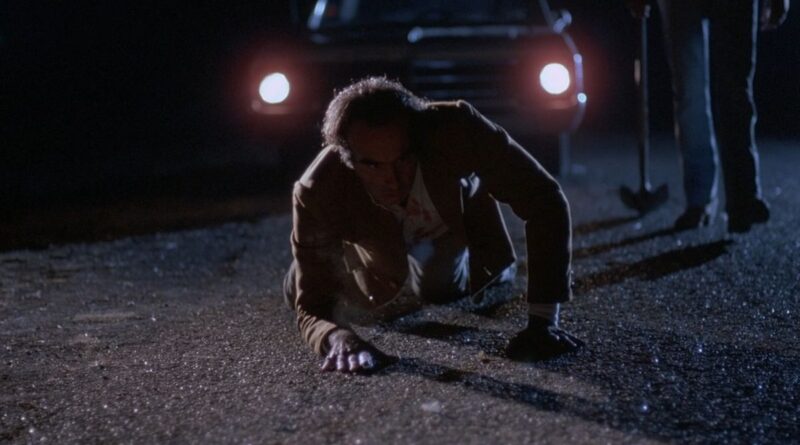Blood Simple (1985)
When a film critic uses the sentence, “You have to pay attention to the words that aren’t being said,” be wary. In some cases, that’s pretension masquerading as insight, a series of words that give the haughty impression of understanding when the critic has no idea what the movie is actually about. But in the case of Blood Simple, one of the most ingeniously plotted crime thrillers of recent memory, it rings true; most of the events of the story are set into motion by the fact that the characters say so little to each other. As you watch everything unfold, you’re made painfully aware of the words the characters aren’t saying, the very words that, in all likelihood, would have prevented some really nasty things from happening.
This darling of several 1984 and ‘85 film festivals – including Sundance, where it won the Grand Jury Prize – marks the directorial debut of Joel Coen, who co-wrote the film with his brother Ethan, the latter doubling as the film’s producer. What a debut it is; apart from the meticulous crafting of the plot, it’s a triumph of suspense, pacing, performance, and lighting, cinematographer Barry Sonnenfeld blending the deep shadows of classic film noir with the eerie soft glow of buzzing neon signs and dirty billboard spotlights. So many visuals are so beautifully shot, so skillful in their integration of lighting effects, they could be captured as stills, framed, and sold as works of modern art.
There isn’t much of the plot I can or would want to give away, although I am obligated to provide the setup. Somewhere in Texas – where seedy dives are located in the middle of barren desert, long roads surrounded by nothing seem to stretch into infinity, and long expanses of plowed farmland separate small rundown cities from even smaller lower-class suburbs – Julian Marty, the owner of a bar (Dan Hedaya) finally gets photographic proof that his wife Abby (Frances McDormand) is having an affair with Ray, one of Marty’s bartenders (John Getz). Quietly enraged, Marty agrees to pay a disgustingly corrupt private detective (M. Emmet Walsh) $10,000 to have both his wife and Ray murdered and disposed of.
This is when everything starts to go wrong. This is also the point at which I have to make very careful word choices, which is to say I’m going to be irritatingly vague. False documentation fools someone into believing something that isn’t true, which in turn leads to a dark turn of events. Not long after, a discovery, coupled with the appearance of a gun belonging to a specific character, devolves into a series of misunderstandings that make two characters look at each other with fear and suspicion. If one could simply communicate with the other, even with just a few simple words, all could have been explained and a very different outcome might have been possible. But both are now afraid of each other, though in reality, neither party is guilty of what the other party thinks.
During these misunderstandings, ugly, violent things happen to people. In one expertly timed scene, a shooting victim is thought dead; when discovered to be alive, the perpetrator uses twisted logic to deal with the problem, ruling out running the victim over and a shovel bludgeoning in favor of a premature burial. Perhaps, in the warped mind of the perp, it’s easy to believe that burying someone alive isn’t the same as murder. The film culminates with a brutal shootout at a studio apartment, one that proves some people will go to any lengths to retrieve items of a personal nature, even if doing so greatly jeopardizes the chances of making a clean getaway.
For a film that doesn’t have a great deal of dialogue, not only does the story come across loud and clear, the performances are such that we completely understand the characters from the inside out. At first glance, Getz and McDormand appear low key, restrained, lethargic. Look closer; spoken words may be lacking, but their glances, when together and apart, convey every ounce of their characters’ drives, confusions, and fears. But no one in this film steals the show better than Walsh, whose private detective character is one of the more memorable personifications of pure evil. To say he has no scruples would be an understatement; his greed – perfectly represented by his portly frame, sweaty face, cigarette smoking, and soft laugh – is so all-consuming that there’s literally no room for anything else.
For something commercially released so early in 1985, Blood Simple is already one of the year’s best films. It’s more than just an absorbing story of small-town murder; it’s a true testament to the art of filmmaking, with meticulous attention paid to how it moves, how it sounds, and how it looks, the latter not merely superficial window dressing but an integral narrative device. It knows how to get your attention, and more importantly, it knows how to keep you hooked. How macabrely apt that one of the film’s symbols is a group of recently caught fish splayed on a table, the metal hooks still piercing their mouths, the lines still attached and easy to grab hold of.




